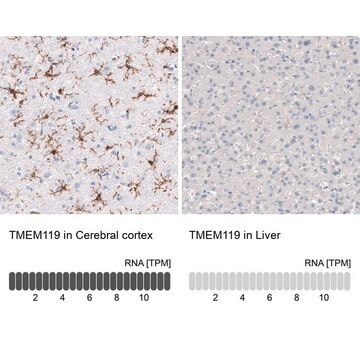Opis ogólny
Dokładamy wszelkich starań, aby dostarczać bardziej ekologiczne produkty alternatywne, które są zgodne z co najmniej jedną z 12 zasad zielonej chemii. To przeciwciało nie zawiera konserwantów, zostało wyprodukowane bez szkody dla zwierząt i jest wyjątkowo stabilne, aby umożliwić wysyłkę i przechowywanie w razie potrzeby, a tym samym jest zgodne z "Zapobieganiem powstawaniu odpadów", "Projektowaniem bezpieczniejszych chemikaliów" i "Projektowaniem pod kątem efektywności energetycznej".
Kliknij tutaj, aby uzyskać więcej informacji.
Przeciwciała 10889 stanowią całkowicie nową generację rekombinowanych przeciwciał monoklonalnych. Każde przeciwciało 10889 jest wytwarzane przy użyciu naszego zastrzeżonego systemu ekspresji rekombinowanej, oczyszczane do jednorodności i precyzyjnie dozowane w celu uzyskania solidnej i wysoce powtarzalnej konsystencji między partiami. Do użytku badaczy udostępniane są wyłącznie klony o najwyższej wydajności. Każde przeciwciało jest walidowane pod kątem wysokiej swoistości i powinowactwa w wielu zastosowaniach, w tym w najczęściej używanym zastosowaniu. Przeciwciała 10889 są niezawodnie dostępne i gotowe do wysyłki, gdy są potrzebne.
Specyficzność
Klon 2C12 to rekombinowane królicze przeciwciało monoklonalne 10889, które specyficznie wykrywa purynoreceptor P2Y 12 (P2RY12). Celuje w epitop w obrębie 22 aminokwasów od C-końcowej domeny cytoplazmatycznej.
Immunogen
Liniowy peptyd sprzężony z KLH odpowiadający 22 aminokwasom z C-końcowej domeny cytoplazmatycznej ludzkiego purynoreceptora P2Y 12 (P2Y12).
Zastosowanie
Testy kontroli jakości
Oceniane metodą Western Blotting w lizacie tkanki móżdżku bydła.
Analiza Western Blotting: Rozcieńczenie 1:1000 tego przeciwciała wykryło P2RY12 w lizacie tkanki móżdżku bydła.
Testowane aplikacje
Analiza Western Blotting: Rozcieńczenie 1:1000 z reprezentatywnej partii wykryło P2RY12 w lizacie tkanki ludzkiego móżdżku.
Analiza immunohistochemiczna (parafina): Rozcieńczenie 1:1000 z reprezentatywnej partii wykryło P2RY12 w skrawkach tkanki ludzkiej kory mózgowej.
Analiza immunofluorescencyjna: Rozcieńczenie 1:1000 z reprezentatywnej partii wykryło P2RY12 w wycinkach tkanki ludzkiej kory mózgowej.
Uwaga: Rzeczywiste optymalne rozcieńczenia robocze muszą być określone przez użytkownika końcowego jako próbki, a warunki eksperymentalne mogą się różnić w zależności od użytkownika końcowego.
Opis wartości docelowych
Purinoceptor P2Y 12 (UniProt: Q9H244; znany również jako P2Y12, receptor ADP-glukozy, ADPG-R, P2T(AC), P2Y(AC), P2Y(cyc), płytkowy receptor ADP P2Y12, P2Y(ADP), SP1999) jest kodowany przez gen P2RY12 (znany również jako HORK3) (Gene ID: 64805) u człowieka. Receptory P2Y to rodzina purynergicznych receptorów sprzężonych z białkiem G (GPCR), które są aktywowane przez zewnątrzkomórkowe nukleotydy. U ludzi wyrażono osiem różnych funkcjonalnych receptorów P2YR, które są podzielone na receptory podobne do P2Y1 i receptory podobne do P2Y12. Receptor P2Y12 jest wieloprzepustowym białkiem błonowym z czterema domenami zewnątrzkomórkowymi, siedmioma domenami transbłonowymi i czterema domenami cytoplazmatycznymi. Większość jego domen transmembranowych wydaje się być pochylona i/lub zagięta. Wiązanie agonistów z receptorem P2Y12 promuje zmianę konformacji w pętlach zewnątrzkomórkowych, co prowadzi do ruchu do wewnątrz helis transbłonowych. Służy jako receptor dla ADP i ATP sprzężonych z białkami G, które hamują system drugiego przekaźnika cyklazy adenylowej. Nie jest aktywowany przez UDP i UTP. Wykazuje wysoką ekspresję w płytkach krwi, a niższy poziom ekspresji obserwuje się w mózgu, płucach i nadnerczach. Jest wymagany do prawidłowej agregacji płytek krwi i krzepnięcia krwi. Jest to dominujący receptor zaangażowany w stymulowaną ADP aktywację receptora glikoproteiny IIb/IIIa. Aktywacja receptora glikoproteiny IIb/IIIa powoduje zwiększoną degranulację płytek krwi i produkcję tromboksanu oraz przedłużoną agregację płytek krwi. Receptor P2Y12 ulega również ekspresji na mikrogleju i jest niezbędny w bólu neuropatycznym po uszkodzeniu nerwów obwodowych. Mutacje w genie P2RY12 zostały powiązane z zaburzeniami krwawienia wynikającymi z poważnego upośledzenia odpowiedzi płytek krwi na ADP, co skutkuje wadliwą agregacją płytek krwi. To rekombinowane przeciwciało monoklonalne 10889, generowane przez naszą zastrzeżoną technologię, oferuje znacznie zwiększoną swoistość, powinowactwo, powtarzalność i stabilność w porównaniu z konwencjonalnymi przeciwciałami monoklonalnymi. (Ref.: Zhang, K., et al. (2014). Nature. 509(7498); 115-118; Burnstock G. (2009). Curr. Pharm. Des. 15(15);1717-35; Damman, P., et al. (2012). J. Thromb. Thrombolysis. 33(2); 143-153).
Postać fizyczna
Oczyszczone rekombinowane królicze przeciwciało monoklonalne IgG, liofilizowane w PBS, 5% trehalozy, o normalnym wyglądzie gruboziarnistej lub półprzezroczystej żywicy. Składniki PBS/trehaloza w preparacie ZooMAb mogą mieć wygląd półstały (żel przypominający kulki) po liofilizacji. Jest to zjawisko normalne. Należy postępować zgodnie z zalecaną procedurą rekonstytucji zawartą w arkuszu danych, aby rozpuścić półstały, przypominający kulki materiał o wyglądzie żelu. Otrzymany roztwór przeciwciała jest całkowicie stabilny i funkcjonalny, co potwierdzają pełne testy funkcjonalne. Nie zawiera biocydów ani konserwantów, takich jak azydek, ani żadnych produktów ubocznych pochodzenia zwierzęcego. Większe opakowania są dostarczane jako wielokrotności 25 µL.
Rekonstytucja
Odtworzyć liofilizowany osad przeciwciała za pomocą 25 μl ultraczystej wody lub soli fizjologicznej buforowanej fosforanem (PBS). Zapoznaj się z naszym
protokołem rekonstytucji i szczegółowymi wskazówkami dotyczącymi aplikacji w zakresie sugerowanych rozcieńczeń początkowych i rodzaju próbki.
Przechowywanie i stabilność
Zaleca się przechowywanie liofilizowanego produktu w temperaturze 2-8°C. Przed rekonstytucją fiolki należy krótko mikrowirować, aby odwirować materiał na dno fiolki. Każdą fiolkę należy odtworzyć, dodając 25 µl przefiltrowanej wody laboratoryjnej lub PBS. Odtworzone przeciwciała można przechowywać w temperaturze 2-8°C lub -20°C w celu długotrwałego przechowywania. Unikać wielokrotnego zamrażania.
Inne uwagi
Stężenie: Stężenie specyficzne dla danej partii można znaleźć w certyfikacie analizy.
Informacje prawne
ZooMAb is a registered trademark of Merck KGaA, Darmstadt, Germany
Oświadczenie o zrzeczeniu się odpowiedzialności
O ile nie określono inaczej w naszym katalogu lub innej dokumentacji firmy dołączonej do produktu(-ów), nasze produkty są przeznaczone wyłącznie do użytku badawczego i nie mogą być wykorzystywane do żadnych innych celów, w tym między innymi do nieautoryzowanych zastosowań komercyjnych, zastosowań diagnostycznych in vitro, zastosowań terapeutycznych ex vivo lub in vivo lub jakiegokolwiek rodzaju konsumpcji lub zastosowania u ludzi lub zwierząt.
Ta strona może zawierać tekst przetłumaczony maszynowo.










